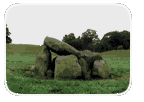   |  The Mystical Significance of Standing Stones The exact nature of stone circles and the rituals practiced among them have long occupied the great archaelogical minds. They may have been agrarian calendars, or astronomical instruments, monuments to deceased chiefs, meeting places or cattle markets. There are probably as many explanations as there are circles. Stones were important to the ancient Celts (they were used for building purposes and often as boundary and memorial markers), and it is not surprising that they should become the habitation of mysterious spirits, or that strange powers should be ascribed to them. In Brittany there is a persistent tradition that these stones were used by the druids to summon and focus Otherworld powers, to create storms and diseases in our own world. Many large stones (particularly what are known as 'single stones', 'great stones' situated on their own) were the object of such druidical worship, and some were certainly associated with the fertility religion that characterised many druidic sects. The configurations of the stones also puzzled the Celts. They were arranged in a number of ways. There were 'inger stones' (large single stones that jutted upwards out of the earth like a warning finger); stone circles (some of which may have been a feature of Celtic worship but many would appear to predate the Celts); Rocking Stones (a flat stone resting on the top of another to form a kind of 'see-saw' - this may be a purely natural phenomenon or it may be the result of the labours of prehistoric engineers) and dolmens and cromlechs (known as Fos-Leac in Ireland, this was traditionally held to be the burial-site of a local chieftain or hero and, more latterly, the resting-place of a saint. It consisted of two upright stones surmounted by a capstone). A number of these stones had specialised powers which formed the beliefs of the communities round about. In Brittany it was widely believed that if a previously infertile woman were to sit astride the capstone of a dolmen, she would conceive within the year, while if two people kissed a certain Kissing Stone in Ireland at the same time (the location of one such stone is given simply as 'Sligo'), their love would last forever (for these and other such beliefs see Bonwick: Irish Druids and Old Irish Religions, 1894).
|
 |